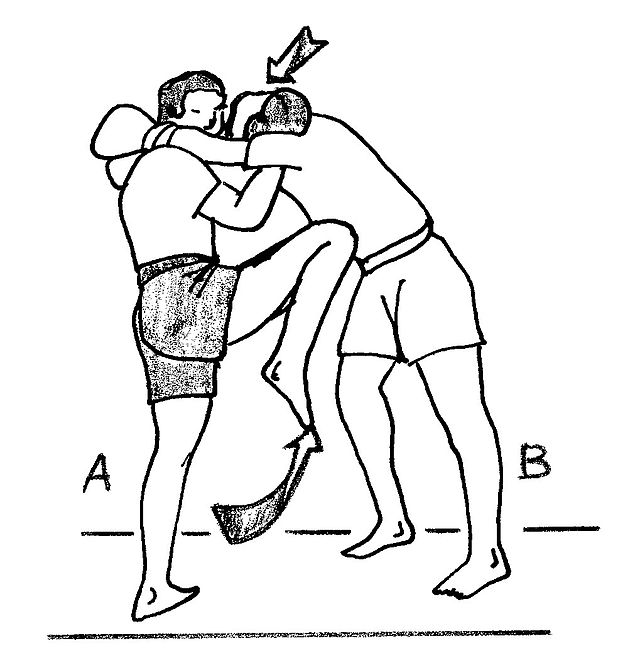Draft
Table of contents
Clinch Theory
Dominant clinchers will push, drag, hang onto, and otherwise unbalance their opponent. Recognizing these dominant positions allows the Muay Khao to rest in relative safety, while the opponent expands significant energy trying to “muscle out.” At the extreme, a fading fighter uses the clinch to play for locked positions, stalling the game until a referee’s break.
Remember then, that the clinch is not a goal in itself. Offensively, you clinch for advantage by scoring hooks and uppercuts, knee and elbow strikes, sweeps and dumps. Defensively, you clinch to neutralize your opponent’s long range game, to rest, or to stall safely for time.
The Importance of Balance
Depth in your clinch
Develop a Clinch System
In older Muay Thai manuals, the clinch was often called the “chest-to-chest” position. But depending on your height and your strength, you may end up preferring to play for top dominance (over), or for bottom dominance (under). Your goal in this section should be to develop a flexible game plan: to recognize common positions, transitions, and counters.
With time, you may develop a “system” that is uniquely yours, playing on your strengths and preferences. For example, as a taller fighter (6’2” or 188cm, 160lb or 73kg), I often find myself in the top-heavy, “over” position, where it’s easier to hide my head over my opponent’s shoulder. From there, I would also to prefer to knee aggressively, since my height makes it easier to clear the waist. The over position also allows me to elbow over my opponents guard. The difference in height naturally directs my attacks upward, and the opponent’s, down.
This preferred game plan goes out of the window when meeting fighters of similar or taller stature. In the “under” game, I do better in hiding or “posting” my head on the opponents chest, digging up, and into the chin with the top of my head. And since kneeing above the belt is difficult with a taller opponent, I will prefer to knee into the thigh, or play for sweeps or body locks. From the bottom, I also have better access to sneaky uppercuts and up-elbows, blocked by the taller fighter’s blind-spots. At a height disadvantage, I therefore concentrate my attention on the bottom half of the body, playing for the advantages that come naturally from the bottom.
Dominance in the clinch thus involves minimizing your opponent’s options for offense, while maximizing your own offensive capabilities. In the prefect world, your clinch would completely smother your opponent into inaction, while allowing you to score freely. Due to the extreme closeup nature of the “chest to chest” position, the offensive capabilities of the clinch favor close range weapons, such as knees, elbows, hooks, and uppercuts. Though quite economical, these strikes still need space to find their target.
Space
Safety in the clinch comes from controlling the opponents neck and arm, as well as from “hiding” the head tightly over an opponent’s shoulder (for a taller fighter) or tucking into the chest, under the chin (for the shorter fighter). This lack of space prevents significant strikes. From the locked position, explosive movement is used to create space filled by knees and elbows.

We are then faced with the fundamental paradox of the clinch: to smother the opponent, you need to take their space away. Any space between you and them needs to be “eaten up” in the process. This consumption of space defines the Muay Khao fighter, who constantly moves forward to pressure their target. But, in the taking away of an opponent’s space, the Muay Khao needs to also open space into which their own strikes can expand. Yet, any such opening also gives offensive room for the opponent. This is the beautiful puzzle at the center of Muay Khao: to find free movement in the action of smothering.
A Dynamic Position
Whatever your preferred position, avoid treating the clinch as a static position. Similar to other forms of specialized grappling, it’s rather a dynamic system, which has to be adapted actively to your opponent. Once you train to recognize common positions automatically, you will fluidly begin to flow between dominant positions, in search for a decisive advantage.